The price of orry routes
Page 27

If you've noticed an error in this article please click here to report it so we can fix it.
MILEAGE increases of between five and 10 per cent would be result of the Government's proposed lorry route network, the Freight Transport Association claimed last week.
And after carrying out a survey of its member companies the FTA believes that even assuming that the average mileage increase was only five per cent the extra cost to the community of the plans would be £115m a year.
The Association has told the Department of the Environment that any national routeing system must be intelligible to drivers. Industry would not accept a system that was not simple and sensible.
Even though the network would be advisory every driver had to be in a position to comply with the rules. On-sight signing was the only way that this could be achieved.
Routeing, the FTA went on, was equally likely to fall if due account was not taken of the vital issue of driver and vehicle facilities.
If it was decided to go ahead with lorry routeing then the final scheme should reflect the current need to improve efficiency
and cut out marginal expenditure.
The FTA strongly held the view that the system should cover the whole of the motorway and primary route network. Cutting out 3,000 miles as far as lorries were concerned would add to costs and make implementation more difficult.
There was no need for the marking of lorries affected by the proposals since the vast majority of vehicles over 16 tons were easily identifiable. Indeed if the network were properly chosen the FTA saw no real need for a specific weight limit to be defined.




























































































































